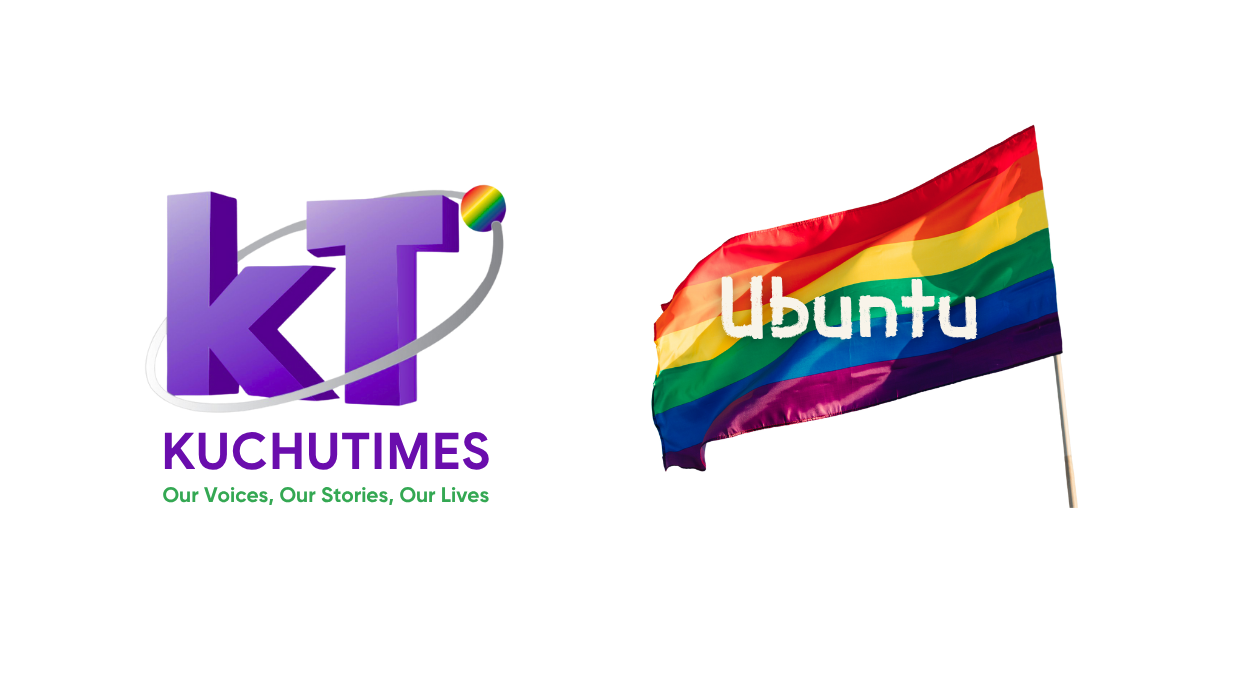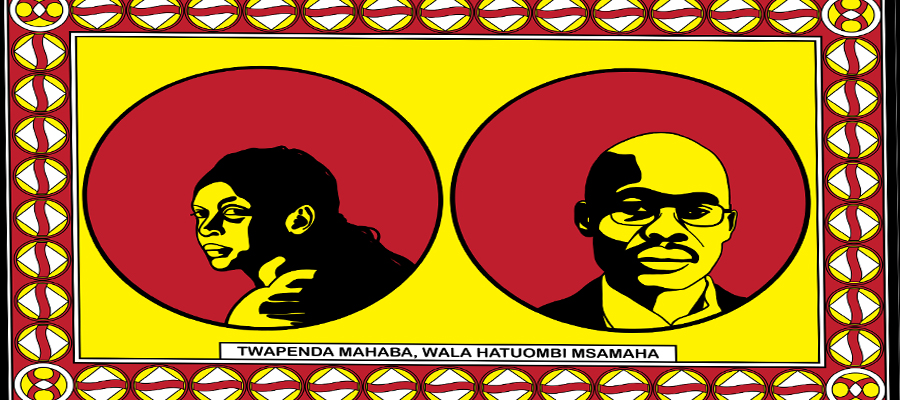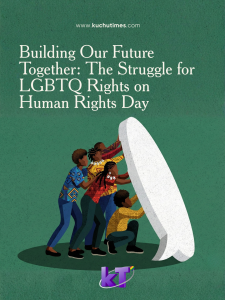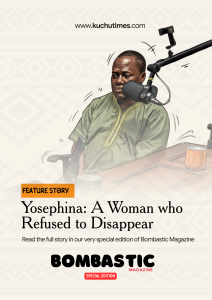Born and raised in Nairobi Kenya, Kawira Mwirichia is a proud queer female visual artist who loves to create beautiful art that changes the world by inspiring and educating the community.
After a series of events that triggered the thought to openly and honorably celebrate African LGBTQ heroes, Mwirichia conceived an idea that gave birth to a kanga series titled “To Revolutionary Type Love” project. These kangas tell stories of the queer movement in Africa and one of her creations features the faces of David Kato, Uganda’s fallen LGBTQ activist (who was murdered at his home on 26th January 2011) and Kasha Jacqueline Nabagesera, one of the pioneers of Uganda’s LGBTQ movement.
Kuchu Times spoke to Mwirichia about the inspiration behind this project and what she hopes to achieve. The highly passionate artist is not one to shy away from the things that give her such drive- she shared how she zeroes down on the people she features and her desire to celebrate these personalities who have so tirelessly and selflessly given so much to the movement. Below are the excerpts of our online chat.
KT: What inspired you to do this project?
KW: Back in 2015, I was part of a friend’s bridal party; I was able to witness the activities that are carried out (culturally) before the bride and groom arrive at the church to be wed. There is (literally) a whole song and dance parade that the groom’s family does even before they enter the bride’s maternal home to show (the bride’s family, and their neighbours) that they are happy to be receiving the girl as a bride. And after they’ve sang loudly enough to convince the mother of the bride that they deserve to come in and receive her daughter, they go ahead to lay down kangas to receive her and take her to the car that will take her to the church. While witnessing all this, it occurred to me that this gesture of open celebration of someone’s love is something that is denied to the LGBTIQ community because of our Queerness. So much that, probably even the most loving and accepting families may not feel safe or comfortable enough to so loudly and publicly celebrate their child’s queer partner. This made me think that perhaps we can use this gesture amongst ourselves – to lay down our own kangas, filled with our own histories – in celebration of ourselves. And that’s what inspired the “To Revolutionary Type Love” project.
KT: How do you zero down on the personalities that you feature?
KW: Each kanga in the “To Revolutionary Type Love” project (TRTL) features a country’s queer history. So when I am designing a country’s kanga, I read as much of the country’s queer history that I can find online and try to understand its backstory and see how it’s grown throughout the years. What were they mainly fighting for? Who were fighting or leading the charge? Did they succeed? What are some of the big events that shape their story? Etc. When sifting through all this information, I am able to find a common narrative that a country is sharing to the world about its LGBTIQ history and this is what I feature on the kanga. For the Uganda kanga particularly, it became pretty clear to me as I read about its history that David Kato and Kasha Nabagesera played huge roles in the country’s queer movement. They’ve even been dubbed the father and mother of the movement (respectively), and that’s why their faces are featured on the kanga. Then the two major queer organizations that formed the kanga’s design are Freedom and Roam Uganda (FARUG) and Sexual Minorities Uganda (SMUG).
KT: How did you raise capital to kick start your project?
KW: Since the beginning, I have been the biggest investor in my own project and have used my own money to pay for what I could to start - and keep - my TRTL work going. I mainly earned an income from creating commissioned art work for organizations, though I’ve dipped into my own personal stash for unplanned expenses that would come up as I figured out how to manage and grow TRTL. I have also been able to sell some kanga prints and bring in some additional money to keep me going, though it’s not at the level that I’d like it to be just yet. And finally, I have been able to successfully apply for quite a few grants. In 2017, I connected with funders who believed in my work and I put together the first TRTL exhibition. Now, I’m looking to partner up with even more supporters as the project grows in its scope and impact. Ultimately, my aim is to have TRTL become a magnificent, queer-driven arts and creative industry here in Kenya, that provides training and employment to hundreds of Kenyan/African queer individuals and whose work impacts our global landscape.
KT: How do you want this project to impact the LGBTQ community in East Africa?
KW: I’d want TRTL to make us a proud community- not the kind of pride people think where we’re going around putting others down, but the kind that allows (and perhaps, even demands) that you occupy your own space wholly. I’d want us to be able to show up in all our flair and magnificence, whatever that looks like for each of us. And I’d want us to be thriving as a community – TRULY thriving. Inside and out.
KT: Where do you see this project in five years?
KW: In five years, I’d want the kangas that are a part of TRTL to be as much a part of the global queer identity as the rainbow flag (in all its variations) currently is. I’d want the artists TRTL works with to be successfully doing their own thing and occupying spaces that the likes of Ru Paul and Todrick Hall currently do. I’d want culture icons like Madonna (with “Vogue”) and Beyonce (with “Run the World”) to be looking at us for inspiration. I’d want TRTL to host the best annual Pride events the world has ever seen.
That’s what I’d want to see in the next five years.
KT: What would you advise an LGBTQ identifying person especially the youth, who would like to pursue similar projects in the future?
KW: There’s a lot I’d love to share as guidance if I could, and especially to address certain seasons they’ll go through in their work, but I guess what I’d say to sum it all up would be to just keep showing up. There will always be difficult times that come up, especially if you’re doing something you’ve never done before, but you’ll be able to learn and get through any obstacle if you just keep showing up. One of my favourite quotes says “Press on! Nothing in the world can take the place of persistence. Talent will not. Nothing is more common than unsuccessful men with talent. Genius will not. Unrewarded genius is almost a proverb. Education will not. The world is full of educated derelicts. Persistence and determination alone are omnipotent” and I’ve found this to be very true in everything I do. Make peace with the fact that things will be hard - to the point of breaking your spirit, sometimes - and just keep finding a way to show up anyway.




